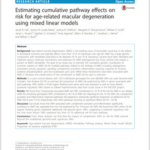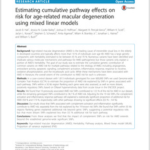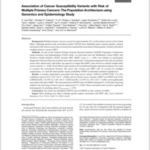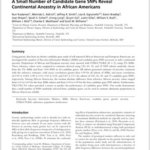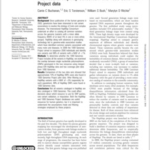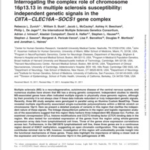Age-related macular degeneration (AMD) is the leading cause of irreversible visual loss in the elderly in developed countries and typically affects more than 10% of individuals over age 80. AMD has a large genetic component, with heritability estimated to be between 45% and 70%. Numerous variants have been identified and implicate various molecular mechanisms and […]
Tag Archives: Genotype
Estimating cumulative pathway effects on risk for age-related macular degeneration using mixed linear models.
Hall JB, Cooke Bailey JN, Hoffman JD, Pericak-Vance MA, Scott WK, Kovach JL, Schwartz SG, Agarwal A, Brantley MA, Haines JL, Bush WS,. Age-related macular degeneration (AMD) is the leading cause of irreversible visual loss in the elderly in developed countries and typically affects more than 10% of individuals over age 80. AMD has a […]
Estimating cumulative pathway effects on risk for age-related macular degeneration using mixed linear models.
Age-related macular degeneration (AMD) is the leading cause of irreversible visual loss in the elderly in developed countries and typically affects more than 10% of individuals over age 80. AMD has a large genetic component, with heritability estimated to be between 45% and 70%. Numerous variants have been identified and implicate various molecular mechanisms and […]
Estimating cumulative pathway effects on risk for age-related macular degeneration using mixed linear models.
Hall JB, Cooke Bailey JN, Hoffman JD, Pericak-Vance MA, Scott WK, Kovach JL, Schwartz SG, Agarwal A, Brantley MA, Haines JL, Bush WS,. Age-related macular degeneration (AMD) is the leading cause of irreversible visual loss in the elderly in developed countries and typically affects more than 10% of individuals over age 80. AMD has a […]
Association of cancer susceptibility variants with risk of multiple primary cancers: The population architecture using genomics and epidemiology study.
Multiple primary cancers account for approximately 16% of all incident cancers in the United States. Although genome-wide association studies (GWAS) have identified many common genetic variants associated with various cancer sites, no study has examined the association of these genetic variants with risk of multiple primary cancers (MPC).As part of the National Human Genome Research […]
Association of cancer susceptibility variants with risk of multiple primary cancers: The population architecture using genomics and epidemiology study.
Park SL, Caberto CP, Lin Y, Goodloe RJ, Dumitrescu L, Love SA, Matise TC, Hindorff LA, Fowke JH, Schumacher FR, Beebe-Dimmer J, Chen C, Hou L, Thomas F, Deelman E, Han Y, Peters U, North KE, Heiss G, Crawford DC, Haiman CA, Wilkens LR, Bush WS, Kooperberg C, Cheng I, Le Marchand L,. Multiple primary […]
A small number of candidate gene SNPs reveal continental ancestry in African Americans.
Using genetic data from an obesity candidate gene study of self-reported African Americans and European Americans, we investigated the number of Ancestry Informative Markers (AIMs) and candidate gene SNPs necessary to infer continental ancestry. Proportions of African and European ancestry were assessed with STRUCTURE (K 2), using 276 AIMs. These reference values were compared to […]
A small number of candidate gene SNPs reveal continental ancestry in African Americans.
Kodaman N, Aldrich MC, Smith JR, Signorello LB, Bradley K, Breyer J, Cohen SS, Long J, Cai Q, Giles J, Bush WS, Blot WJ, Matthews CE, Williams SM,. Using genetic data from an obesity candidate gene study of self-reported African Americans and European Americans, we investigated the number of Ancestry Informative Markers (AIMs) and candidate […]
A comparison of cataloged variation between International HapMap Consortium and 1000 Genomes Project data.
Since publication of the human genome in 2003, geneticists have been interested in risk variant associations to resolve the etiology of traits and complex diseases. The International HapMap Consortium undertook an effort to catalog all common variation across the genome (variants with a minor allele frequency (MAF) of at least 5% in one or more […]
A comparison of cataloged variation between International HapMap Consortium and 1000 Genomes Project data.
Buchanan CC, Torstenson ES, Bush WS, Ritchie MD,. Since publication of the human genome in 2003, geneticists have been interested in risk variant associations to resolve the etiology of traits and complex diseases. The International HapMap Consortium undertook an effort to catalog all common variation across the genome (variants with a minor allele frequency (MAF) […]
Interrogating the complex role of chromosome 16p13.13 in multiple sclerosis susceptibility: independent genetic signals in the CIITA-CLEC16A-SOCS1 gene complex.
Multiple sclerosis (MS) is a neurodegenerative, autoimmune disease of the central nervous system, and numerous studies have shown that MS has a strong genetic component. Independent studies to identify MS-associated genes have often indicated multiple signals in physically close genomic regions, although by their proximity it is not always clear if these data indicate redundant […]
Interrogating the complex role of chromosome 16p13.13 in multiple sclerosis susceptibility: independent genetic signals in the CIITA-CLEC16A-SOCS1 gene complex.
Zuvich RL, Bush WS, McCauley JL, Beecham AH, De Jager PL, , Ivinson AJ, Compston A, Hafler DA, Hauser SL, Sawcer SJ, Pericak-Vance MA, Barcellos LF, Mortlock DP, Haines JL,. Multiple sclerosis (MS) is a neurodegenerative, autoimmune disease of the central nervous system, and numerous studies have shown that MS has a strong genetic component. […]


